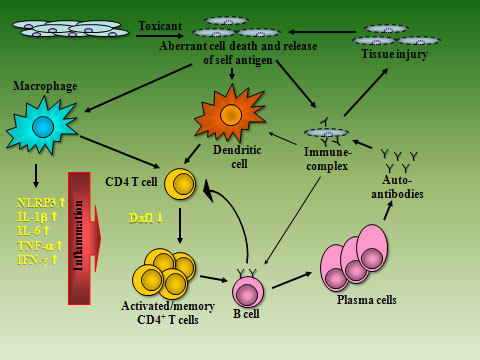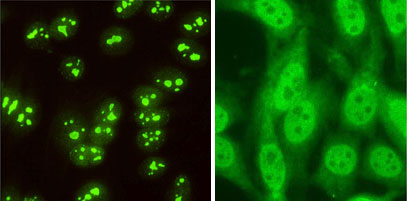The Pollard Lab
Research Topics

The Model
Susceptibility to autoimmune disease can be impacted by environmental factors which encompass everything around us including the air we breathe, the water we drink, the food we eat, synthetic and natural chemicals, microorganisms, radiation, industrial by-products, and physical factors. Epidemiological analysis has suggested that exposure to mercury can be associated with increased risk of autoimmunity. Mercury exposure can occur in many ways including skin care products such as skin lightening creams, and also during artisanal gold mining. The human populations at risk of exposure are sizable and diverse. Mercury is used by small scale gold miners in 50 developing countries and is a major source of mercury contamination in the associated rural communities. It is believed that between 10-15 million people, including women and children are directly involved in artisanal gold mining.
Murine mercury–induced autoimmunity (mHgIA) can be induced by numerous exposure routes and chemical forms including subcutaneous injection or oral ingestion of mercuric chloride (HgCl2), inhalation of mercury vapor, and dental or peritoneal implantation of mercury containing dental amalgam. The severity of disease is dependent upon strain, gender and exposure dose. The features of mHgIA, including lymphadenopathy, hypergammaglogulinemia, humoral autoimmunity, and immune-complex deposits, are consistent with the systemic autoimmunity of systemic lupus erythematosus (SLE). The most characteristic aspect of autoimmunity induced by mercury is an MHC-restricted autoantibody response against fibrillarin, a nucleolar protein component of the box C/D small nucleolar ribonucleoprotein (snoRNP) complexes. Anti-fibrillarin antibodies are found in systemic autoimmune diseases SLE and scleroderma.

Prototypical antibodies in mHgIA: MHC restricted anti-nucleolar (left panel) and non-MHC restricted anti-nuclear antibodies (right panel) demonstrated by indirect immunofluorescence on HEp-2 cells.
References
Pollard KM, Hultman P, Kono DH. Toxicology of autoimmune diseases. Chem. Res. Toxicol. 2010. 23:455-66.
Role of innate and adaptive immune responses in xenobiotic-induced autoimmunity
Immunity consists of innate and adaptive responses. The innate immune system, although made up of highly specialized cells, recognizes and responds to pathogens in a way that does not confer long-lasting or protective immunity. Innate immune systems are found in all classes of plant and animal life. The innate immune system also plays a vital role in the activation of the evolutionarily younger adaptive immune response. Unlike innate immunity, adaptive immunity is highly specific, producing responses that target a particular antigen. Adaptive immunity is also the mediator of immunological memory which allows a faster, more effective response to a previously encountered antigen. Both innate and adaptive immunity contribute to autoimmunity.
As noted below mHgIA is regulated by specific gene products, most of which are integral to adaptive immune responses. However activation of cells important for the adaptive response in mHgIA requires innate immune cells. Mercury-induced activation of T cells requires an adherent cell population in the spleen and is dependent upon IL-1α, a proinflammatory cytokine produced mainly by macrophages.
Complement is part of the innate immune response and can contribute to adaptive immune responses. Complement activation is tightly regulated. Deficiency in decay accelerating factor 1 (Daf1 or CD55), a complement regulatory protein, has been shown to exacerbate development of various autoimmune diseases including mHgIA. Recent studies have suggested this may be explained by Daf1 acting to limit T cell hyper-responsiveness. It has been suggested that the absence of Daf1 aggravates autoimmune disease in a complement dependent manner, but others have shown that activation of T cells in the absence of Daf1 can be complement independent. However, the relationship between Daf1, complement components, lymphocyte activation, cytokine expression and antibody production remains to be determined in mice that are not Daf1 deficient. We have recently demonstrated, in mHgIA, that an accumulation of CD44hi Daflo CD4+ T cells is associated with the development of autoimmunity. In this study we observed that complement depletion does not affect the accumulation of activated CD4+ T cells, elevation of splenic IL-4 expression or autoantibody production in mHgIA. In addition, neither the accumulation of CD44hi Daflo CD4+ T cells nor the downregulation of Daf1 expression on CD4+ T cells were influenced by a lack of complement. These studies show that the initiating events in xenobiotic-induced autoimmunity, including lymphocyte activation, cytokine expression and autoantibody production, are not dependent on complement.
References
Pollard KM and Landberg GP. The in vitro proliferation of murine lymphocytes to mercuric chloride is restricted to mature T cells and is interleukin 1 dependent. Int. Immunopharm. 2001. 1:581-593.
Cauvi DM, Cauvi G, Pollard KM. Reduced expression of decay-accelerating factor 1 on CD4+ T cells in murine systemic autoimmune disease. Arthritis. Rheum. 2007. 56:1934-44.
Toomey CB, Cauvi DM, Song WC, Pollard KM. Decay-accelerating factor 1 (Daf1) deficiency exacerbates xenobiotic-induced autoimmunity. Immunology. 2010. 131:99-106.
Cauvi DM, Toomey CB, Pollard KM. Depletion of complement does not impact initiation of xenobiotic-induced autoimmune disease. Immunology. 2011 Dec 5. doi: 10.1111/j.1365-2567.2011.03545.x. [Epub ahead of print]
Xenobiotic-induced acceleration of idiopathic systemic autoimmunity
Genetic and environmental factors act synergistically at several stages or checkpoints to influence autoimmune disease. These observations predict that individuals susceptible to spontaneous autoimmunity should be more susceptible following xenobiotic exposure by virtue of the presence of predisposing background genes. To test this possibility, mouse strains with differing genetic susceptibility to murine lupus were examined for acceleration of autoimmune features characteristic of spontaneous systemic autoimmune disease following exposure to mercury. Mercuric chloride (HgCI2) significantly accelerated systemic disease in a strain-dependent manner. Autoimmune prone NZBWF1 mice had accelerated lymphoid hyperplasia, hypergammaglobulinemia, autoantibodies, and immune complex deposits after exposure to HgCl2. HgCl2 also exacerbated immunopathologic manifestations in autoimmune-prone MRL-Fas+/+ and MRL-FasIpr mice. However, there was less disease acceleration in MRL-FasIpr mice likely due to the fact that environmental factors are less critical for disease induction when there is strong genetic susceptibility. Non-major histocompatibility complex genes also contributed to mercury exacerbated disease, as the nonautoimmune AKR mice, which are H-2 identical with the MRL, showed less immunopathology than either MRL substrains. This study demonstrates that genetic susceptibility to spontaneous systemic autoimmunity can be a predisposing factor for HgCI2-induced autoimmunity.
The diverse genetic backgrounds of autoimmune-prone murine models, which produce both quantitative and qualitative differences in disease expression, may be a valuable resource for studying the influence of environmental exposure on autoimmune disease in sensitive populations. We tested this premise by exposing autoimmune-prone BXSB and nonautoimmune C57BL/6 mice to HgCl2. Although both strains express a mHgIA nonsusceptible H-2 haplotype, exposure to HgCl2 accelerated systemic autoimmunity in both male and female BXSB mice, whereas the C57BL/6 mice were resistant. The subclasses of anti-chromatin antibodies elicited in BXSB mice by mercury exposure were more consistent with the predominant Th1-type response of idiopathic disease than with the Th2-type response found in mHgIA. The appearance and magnitude of both humoral and cellular features of systemic autoimmunity correlated with mercury dose. Furthermore, environmentally relevant tissue levels of mercury were associated with exacerbated systemic autoimmunity. These studies demonstrate that xenobiotic exposure can accelerate spontaneous systemic autoimmunity, and they support the possibility that low-level xenobiotic exposure enhances susceptibility to systemic autoimmunity in genetically susceptible individuals.
References
Pollard KM, Pearson DL, Hultman P, Hildebrandt B, Kono DH. Lupus-prone mice as models to study xenobiotic-induced acceleration of systemic autoimmunity. Environ. Health. Perspect. 1999. 107 Suppl 5:729-35.
Pollard KM, Pearson DL, Hultman P, Deane TN, Lindh U, Kono DH. Xenobiotic acceleration of idiopathic systemic autoimmunity in lupus-prone bxsb mice. Environ. Health. Perspect. 2001. 109:27-33.
Identification of genes that confer resistance or susceptibility to xenobiotic-induced systemic autoimmunity
Predisposition to xenobiotic-induced autoimmunity has been shown to be influenced by both MHC and non-MHC genes, as well as susceptibility to spontaneous lupus, in mice and other experimental animals. Among the various mouse strains examined, the DBA/2 lack susceptibility to murine mercury-induced autoimmunity, despite expressing a susceptible H-2 haplotype (H-2d). To define the genetic basis for this trait, two genome-wide scans were conducted using F2 intercrosses of the DBA/2 strain with either the SJL or NZB strains, both of which are highly susceptible to mHgIA. A single major quantitative trait locus on chromosome 1, designated Hmr1, was shown to be common to both crosses and encompassed a region containing several lupus susceptibility loci. Hmr1 was linked to glomerular immune complex deposits and not autoantibody production, suggesting that DBA/2 resistance to HgIA may primarily involve the later stages of disease pathogenesis. Identification and characterization of susceptibility/resistance genes and mechanisms relevant to the immunopathogenesis of mercury-induced autoimmunity should provide important insights into the pathogenesis of autoimmunity and may reveal novel targets for intervention. Intriguingly, Daf, described above, resides within the Hmr1 locus.
Other genes are required for susceptibility to mHgIA. Principal among these is the Th1 cytokine interferon-γ (Ifng) and its receptor Ifngr. The results here indicate that Th1/Th2 cytokine imbalance does not directly play a role in susceptibility to mercury-induced autoimmunity, and suggest that the dependence on Th1-type responses in certain autoimmune diseases is due to the requirement for IFN-γ for Ab production to weakly antigenic self molecules. Co-stimulatory molecules CD28 and CD40 ligand are also required. In this case our studies show that signaling via both CD28 and CD40L is important for T cell activation and subsequent autoimmunity in mHgIA, and indicate that breaking of self tolerance in mHgIA requires signaling via both the CD28/B7 and CD40/CD40L pathways.
References
Kono DH, Balomenos D, Pearson DL, Park MS, Hildebrandt B, Hultman P, Pollard KM. The prototypic Th2 autoimmunity induced by mercury is dependent on IFN-gamma and not Th1/Th2 imbalance. J. Immunol. 1998. 161:234-40.
Kono DH, Park MS, Szydlik A, Haraldsson KM, Kuan JD, Pearson DL, Hultman P, Pollard KM. Resistance to xenobiotic-induced autoimmunity maps to chromosome 1. J. Immunol. 2001. 167:2396-403.
Pollard KM, Arnush M, Hultman P, Kono DH. Costimulation requirements of induced murine systemic autoimmune disease. J. Immunol. 2004. 173:5880-7.

